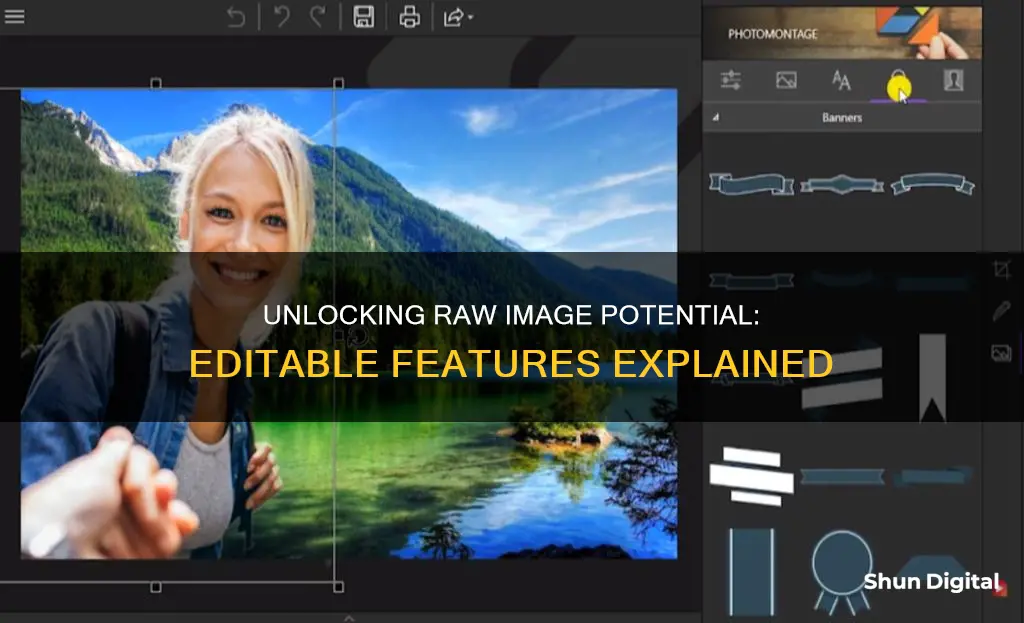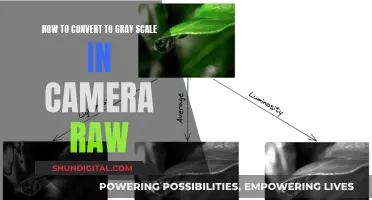
Camera raw image files contain unprocessed or minimally processed data from the image sensor of a digital camera. They are often likened to digital negatives, as they can be processed and printed in different ways to produce different results. Raw files are editable in a number of ways, including white balance, tonal range, contrast, colour saturation, and sharpening.
What You'll Learn

White balance adjustments
In-Camera White Balance Adjustments
Shooting in RAW gives photographers the flexibility to adjust the white balance of their images after capture. While in-camera white balance settings can be applied to RAW images, they are not baked in and can be modified later in post-processing software. This provides a safety net for photographers, allowing them to focus on capturing the moment without worrying about getting the perfect white balance every time.
Most modern DSLR cameras offer automatic white balance (AWB) functions, which can produce decent results in many situations. However, for more precise control, photographers can opt for custom white balance adjustments. By choosing a setting that matches the lighting conditions (e.g., cloudy, sunny, incandescent), photographers can get a more accurate white balance straight out of the camera.
Post-Processing White Balance Adjustments
The real power of shooting in RAW when it comes to white balance adjustments lies in post-processing. RAW files preserve all the image data recorded by the camera's sensor, giving photographers a wide range of possibilities for adjustments.
Using software like Adobe Lightroom or Photoshop, photographers can easily tweak the white balance of their images. This can be as simple as adjusting the Temperature Slider or choosing from various lighting condition options in the White Balance (WB) dropdown menu. For precise adjustments, photographers can also use a gray card to set a custom white balance, ensuring perfect colour accuracy.
Advantages of White Balance Adjustments in RAW
Correcting the white balance on a RAW file does not harm the integrity of the image. The non-destructive nature of RAW means that adjustments can be made without permanently altering the original data. This allows photographers to experiment with different white balance settings and find the perfect look for their images.
RAW files also offer a wider range of colours and tones compared to JPEGs, giving photographers more flexibility in their white balance adjustments. With 12 or 14 bits of intensity information per channel, RAW files can capture and display a much broader spectrum of colours, ensuring smooth transitions and accurate colour representation.
Additionally, shooting in RAW provides the ability to adjust the white balance of an image to settings that aren't available in-camera. This level of control allows photographers to fine-tune their images and achieve their creative vision.
GoPro Charging Time: How Long Until Your Camera's Ready?
You may want to see also

Sharpness and noise adjustments
When you shoot in JPG, the camera automatically applies a number of edits to the image data as part of the conversion process to give the final image a particular look. This includes adjustments to the image's sharpness, noise, colour saturation, and contrast. While the camera software is generally fine at these adjustments, you get much finer control over sharpness and noise reduction if you use a dedicated image editing tool like Adobe Lightroom.
When you shoot in RAW, you can adjust the sharpness of the image using a simple slider, which gives you control over how much you want to sharpen. The Radius slider controls the scope of the effect of your sharpening slider. The Detail slider lets you adjust how much sharpening is applied to edges and textures in the image. A lower setting will generally sharpen edges to remove blur in an image, while higher settings will emphasise textures in the image. The Masking slider controls the edge mask. When set to zero, everything in the image is sharpened. When set to 100, most of the sharpening occurs on the strongest edges in the image.
When shooting in JPG, the camera also applies noise reduction as part of the conversion process. This involves trading off detail for smoothness by removing small fluctuations. However, when shooting in RAW, you can adjust the noise reduction settings to fine-tune the colour saturation of the image. Image noise includes luminance (grayscale) noise, which makes an image look grainy, and chroma (colour) noise, which is visible as coloured artefacts in the image.
Photos taken with high ISO speeds or less sophisticated digital cameras can have noticeable noise. You can adjust the Luminance Detail, Luminance Contrast, and Colour Detail sliders to reduce luminance noise and control the luminance noise threshold. Higher values preserve more detail but can produce noisier results, while lower values produce cleaner results but also remove some detail. You can also reduce colour noise by adjusting the colour noise threshold. Higher values protect thin, detailed colour edges but can result in colour specking, while lower values remove colour speckles but can result in colour bleeding.
VTech Kidizoom Camera: What's in the Box?
You may want to see also

Exposure
When shooting in RAW, photographers can adjust the exposure of their images during post-processing. This is done by lightening or darkening the image using an "exposure slider" in their editing software. Adjusting the exposure can help to capture the desired mood of a scene, even if the original image was too dark or too bright.
In addition to overall exposure adjustments, RAW files allow for more precise modifications to the image's highlights, shadows, and blacks. For example, if the sky in a photo is blown out (completely lacking in detail), the highlights and whites can be lowered to bring back some detail. Conversely, if the image appears too flat, the blacks can be adjusted to add more contrast and depth.
The histogram is a useful tool for identifying exposure issues in a RAW image. It provides a visual representation of the tonal distribution in the image, making it easy to spot areas of clipping or lost detail. Adjustments to the exposure, highlights, and shadows will be reflected in the histogram, making it easier to fine-tune these settings.
It's important to note that while RAW files offer more flexibility in editing exposure, they also require additional processing time and storage space compared to JPEGs. Photographers need to consider these trade-offs when deciding whether to shoot in RAW or JPEG format.
Charging the iForce Camera: A Step-by-Step Guide
You may want to see also

Image compression
Camera raw image files contain unprocessed or minimally processed data from the image sensor of a digital camera, motion picture film scanner, or other image scanner. Raw files are so named because they are not yet processed and contain large amounts of potentially redundant data. They are often referred to as "digital negatives" because the data can be processed and printed in different ways to produce different results, just like the negative from a film camera.
Raw files are editable and can be converted (electronically developed) in a non-destructive manner multiple times in observable, reversible steps to reach a visually desired image. They offer maximum editing flexibility and a wide range of settings that can be modified after capture.
One of the most important editable features of a camera raw image is its compression. Compression lowers file size by reducing colour, contrast, and sharpness from images. There are three types of compression: uncompressed, lossless compressed, and compressed (also known as lossy compressed).
An uncompressed raw file preserves all of the data in an image without compression. As all image data is stored with no impact on quality, you have the freedom to manipulate aspects of the photo like brightness, colour, sharpness, and noise reduction with minimal quality loss. The main drawback of uncompressed raw files is their larger file sizes.
Lossless compression is a format that allows you to reduce image size without compromising on quality. A losslessly compressed image is processed by post-processing software and the data is decompressed like a ZIP file. This is a popular format that occupies less space with minimal quality loss.
Compressed raw, or lossy compression, is a format that reduces the data in a photo. An image captured in compressed raw occupies less storage space but once an image is stored in this format, it cannot be decompressed, meaning the image will lose some of its data.
Other editable features of a camera raw image include sharpness, exposure, curves, and colour.
How Masking in Adobe Camera Raw Transforms Photos
You may want to see also

Image editing
White Balance
White balance refers to the colour tone of an image. When you shoot in raw format, you have the flexibility to adjust the white balance during post-processing. This allows you to correct the colour temperature and ensure that the image appears more natural and similar to the scene you captured.
Exposure and Dynamic Range
Raw images provide a wider dynamic range, allowing you to capture more detail in both the highlights and shadows of your image. When editing, you can adjust the exposure to brighten or darken your image while retaining more information than you would with a JPEG file. This is particularly useful when you have bright skies or dark subjects in your photos.
Colour Profile and Saturation
With raw images, you have the ability to fine-tune the colour profile and saturation of your image. You can make precise adjustments to individual colour channels, ensuring that the colours in your photo are accurate and vibrant.
Sharpness and Noise Reduction
When shooting in raw, you have greater control over the sharpness and noise reduction of your image. This is especially beneficial for low-light or indoor photography, as you can reduce noise and enhance the overall clarity of your photos.
Bit Depth and Colour Depth
Raw files offer a higher bit depth, which translates to a broader colour depth. This means your images can capture and display a wider range of colours, providing more flexibility during editing.
Non-Destructive Editing
One of the most significant advantages of editing raw images is that the process is non-destructive. Your original raw file remains unchanged, and any adjustments you make are stored separately. This gives you the freedom to experiment with different editing styles without permanently altering your original image.
File Format Conversion
When you're finished editing your raw image, you'll need to convert it to a standard file format, such as JPEG or TIFF, to share or print your photo. Keep in mind that when you convert a raw file, some data compression may occur, resulting in a slight loss of image information.
Maximizing Camera Battery Life: Tips and Tricks
You may want to see also
Frequently asked questions
A camera raw image is an unprocessed image file, which means that you can edit features such as white balance, tonal range, contrast, colour saturation, and sharpening.
You can use a range of software to edit a camera raw image, including Adobe Photoshop Lightroom, Corel PHOTO-PAINT, and the software that comes with your camera, such as Canon's Digital Photo Professional.
Camera raw images give you greater control over the final image, as you can edit the image without losing any data. They also allow you to make adjustments to the white balance, colour temperature, sharpness, and contrast.







